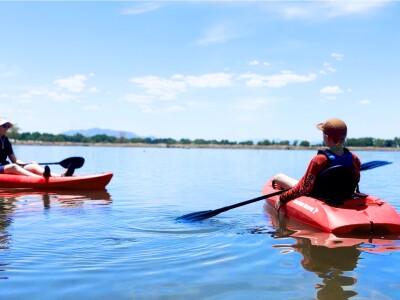Brigham Young University undergraduate engineers demonstrated a portable workstation that creates custom insoles for shoes in less than 30 minutes on Tuesday. The team, sponsored by a Utah entrepreneur, was assigned to take a process that currently requires days and reduce it to minutes, with the potential for their invention to be an option for podiatrists' offices, athletic footwear stores or even ski outfitters.
"This group has done an outstanding job helping me make this product idea into a reality," said sponsor Brent Johnson, an experienced engineer and former plant manager at large manufacturing facilities. "In the end, they came up with an end product that was far superior to what I had originally envisioned."
Johnson's wife, Leslie, has been testing the insoles produced by the students' machine. "I've been wearing them for weeks now, and they are terrific," she said.
Johnson, who has a master's in engineering from MIT, was inspired to develop a better way of developing "orthotics," as such custom insoles are known, after dealing with delays and problems in getting them for his son, who has cerebral palsy. After struggling to find time to work on his business idea while he was also working full time, he turned to BYU.
The project is one of two dozen that culminated Tuesday at the final presentations for the mechanical engineering department's yearlong "Capstone" course. Multidisciplinary teams of students presented their finished projects to corporate sponsors such as Nestle, John Deere and Union Pacific seeking real solutions to their engineering challenges. The program, founded in 1990, has completed more than 400 projects for clients and has more potential sponsors than teams available.
"Capstone was developed to improve our students' education while providing engineering resources for mid- to back-burner projects for sponsoring companies," said Gregg Warnick, Capstone external relations coordinator."Student teams take real-life projects from concept generation and modeling to working prototype.The companies receive all the intellectual property that is developed, and the course is also an effective way to evaluate potential employees over an extended period of time compared to traditional interviews."
The "Sole Orthotic Solutions" team conceived, designed and built an integrated system the size of a desk that begins by acquiring a computerized image of a customer's foot from a pressure pad. Using software written by the team's electrical and computer engineering major, a precision device then reproduces the shape of the foot on a "pin mold," which looks like a bed of nails. A vacuum system then forms a heated slab of plastic around the mold, producing the finished product.
Millions of Americans wear orthotics some for extra arch support, some to compensate for injury or disability, and others for simply a better fit with their shoes. The current standard in the industry is to create a digital image or plaster mold of the customer's foot, then send it to a lab where the orthotics are made by hand or with a milling machine, then sent back for final fitting. The process takes one to two weeks, and sometimes longer if re-fitting is required.
The team, which also included three mechanical engineering majors and an industrial design major, spent 25 to 30 hours per week since September brainstorming, research, testing and building prototypes. Eric Radford, Keith Stolworthy, Tyson Triplett, Caleb Waugh and Jonathan Woahn were "coached" by Ken Hardman, a Boeing engineer and part-time BYU engineering instructor.
Writer: Lee Simons














